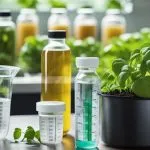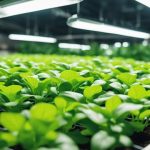When you engage in hydroponic gardening, nutritional precision is the key to healthy plant growth. Your hydroponic system relies on a balanced nutrient solution to feed your plants, delivering the essential minerals and vitamins they need, directly to their roots. Do hydroponic nutrients go bad? The question is crucial because the integrity of your nutrient solution can have a direct effect on the success of your garden.

Understanding the shelf life of hydroponic nutrients helps you ensure your plants are getting the nourishment they require. Typically, these nutrients are quite durable when stored properly. Still, over time, they can lose potency, which means the effectiveness of providing your plants with their dietary needs may diminish. Factors such as exposure to heat, air, and moisture can accelerate this degradation. By keeping these points in mind and organizing proper storage, you can maintain the efficacy of your hydroponic nutrients and continue to nourish your plants effectively.
Understanding Hydroponic Nutrients
When you venture into the world of hydroponics, understanding the role and longevity of nutrients in your system is key to nurturing healthy plants.
Comparing Hydroponic Nutrients to Soil-Based Nutrients
In soil-based cultivation, plants obtain nutrients like nitrogen, potassium, phosphorus, calcium, magnesium, and iron from the soil, which acts as a buffer supplying these elements in organic and mineral forms. Hydroponic nutrients, on the other hand, must be delivered in a soluble form directly to plant roots in water, minus the soil medium. This means you have more control over the availability and balance of nutrients with immediate effect on plant health.
- Macronutrients such as nitrogen, potassium, and phosphorus are crucial for your plants’ growth, providing the basic building blocks for cell structure, energy transfer, and photosynthesis.
- Calcium and magnesium play vital roles too, contributing to the stability of cell walls and the synthesis of chlorophyll.
- Micronutrients like iron are required in smaller quantities but are just as essential for plant health, influencing various growth processes.
In hydroponic systems, these nutrients are often combined into a pre-made hydroponic nutrient mixer or provided as separate components, allowing you to tailor the nutrient profile, which isn’t as easily done with traditional soil-based gardening. As you manage your hydroponic garden, remember that these nutrient solutions can lose effectiveness over time and should be monitored closely for indicators such as changes in color or consistency, which signal a need for replacement to maintain plant health.
How Long Do Hydroponic Nutrients Last Before Mixing?
Hydroponic nutrients before mixing, when stored properly, can last a significant amount of time. Here are some general guidelines:
- Shelf Life: Unopened, concentrated hydroponic nutrients typically have a shelf life of about one to two years from the date of manufacture. However, this can vary depending on the brand and the specific formulation of the nutrients.
- Storage Conditions: To maximize shelf life, store the nutrients in a cool, dark place. Extreme temperatures, direct sunlight, and moisture can degrade the nutrients over time.
- Packaging: The type of packaging can also affect the shelf life. High-quality, sealed containers that prevent exposure to air and light will help extend the life of the nutrients.
- Chemical Stability: Some nutrient components are more stable than others. For example, mineral salts that are common in hydroponic nutrients tend to have a long shelf life, while organic components or those with more complex molecules may break down more quickly.
- Manufacturer’s Expiration Date: Always check the manufacturer’s expiration date or batch number for the most accurate assessment of how long the product will last before mixing.
- Signs of Degradation: Look for signs that the nutrients have gone bad, such as changes in color, texture, or smell. If the product has solidified, separated, or developed an off-odor, it’s best to discard it.
Remember, once mixed with water, hydroponic nutrients should be used within a short period, typically a week or two, as they can become a breeding ground for bacteria and fungi once diluted. Always mix nutrients in clean containers with clean water and follow the manufacturer’s instructions for use and storage.
How Long Can Mixed Nutrients Sit for?
When you’re cultivating plants hydroponically, prepping your nutrient solution is a key step. But once mixed, you might wonder how long you can store that nutrient solution before it becomes less effective or unusable. Typically, a mixed nutrient solution for your hydroponic system can last about one to two weeks, as they can become a breeding ground for bacteria and fungi once diluted.
However, the exact time can vary based on a few factors like temperature, light exposure and oxidization. To get the best out of your mixed hydroponic nutrients, it’s crucial to maintain the right conditions. Always mix nutrients in clean containers with clean water and follow the manufacturer’s instructions for use and storage.
Any sign of cloudiness or foul odor is a red flag that your nutrient solution may be compromised. When in doubt, it’s better to mix a fresh batch than risk the health of your plants. Keeping these guidelines in mind will help you maintain a robust hydroponic garden with optimal plant growth.
Factors Affecting Nutrient Longevity
When you’re looking to maintain the effectiveness of your hydroponic nutrients, it’s essential to consider the environmental factors that can influence their longevity. From temperature fluctuations to pH levels, each plays a pivotal role in nutrient stability.
Temperature and Environment Impact
The temperature and the surrounding environment are crucial factors that determine how long your hydroponic nutrients will retain their potency. Storing your nutrients in a cool, consistent environment helps prevent degradation. High temperatures can increase the rate at which nutrients break down, reducing their effectiveness. For optimal shelf life, store your nutrient solutions away from direct sunlight and in a location that maintains a steady, moderate temperature.
The Role of pH in Nutrient Stability
The stability of hydroponic nutrients also depends on maintaining the correct pH level of your water and nutrient solution. A pH that is too high or too low can cause nutrients to precipitate out of the solution, making them unavailable to your plants and potentially leading to their degradation over time. You should regularly check and adjust the pH level to ensure it remains within the ideal range for nutrient stability, which usually lies between 5.5 and 6.5 on the pH scale.
Storage and Maintenance of Hydroponic Nutrients
Effective storage and maintenance are crucial for preserving the quality of your hydroponic nutrients. These procedures ensure that both liquid and dry formulations remain potent and free from contamination.
Proper Storage Practices
When storing hydroponic nutrients, it’s important to choose containers that shield the contents from any harmful elements. Here’s what you should consider:
- Direct Sunlight: Always keep nutrients out of direct sunlight which can degrade their quality.
- Containers: Opt for opaque containers to prevent light penetration, and ensure all containers are clean and free from contaminants.
- Liquid Nutrients: Store your liquid nutrient mixtures in a cool, dark place, ideally between 60°F to 75°F (15.5°C to 24°C).
- Solution Temperature: Maintaining a stable temperature is vital, as fluctuations can affect the nutrient efficacy.
- Dry Nutrients: Keep granules and powders dry to prevent clumping or caking. It is essential to protect dry nutrients from any moisture.
- Airtight Container: Use airtight containers to prevent air exposure that can lead to oxidation and degradation of the nutrients.
Signs of Nutrient Degradation
Being aware of signs that your hydroponic nutrients are degrading can save you from using ineffective or potentially harmful solutions. Pay attention to the following:
- Clumping: If dry nutrients have absorbed moisture, they may form clumps or cakes. This can affect their solubility and your ability to measure them correctly.
- Change in Color or Smell: Any changes in the color or odor of your nutrient solutions can indicate contamination or nutrient breakdown.
- Granules Consistency: For dry nutrients, a change in the texture or a caked consistency is a clear sign of degradation.
Remember, by adhering to proper storage techniques and being observant of changes in your nutrients, you can ensure your hydroponic system receives the full benefits of a nutrient-rich solution.
Using and Disposing of Hydroponic Nutrients
When feeding your plants in a hydroponic system, understanding how to properly mix, manage, and dispose of nutrients is crucial for plant growth and environmental health.
Mixing Nutrients and Managing Solutions
You might wonder, “can you mix nutrients in advance in water?” The answer is yes, but it’s important to do it correctly. Pre-mixing a batch of nutrients can save time, but make sure to check the pH balance and nutrient concentration before adding it to your plants. Store any premixed solutions in a cool, dark location to prevent degradation. Regularly monitor your reservoir’s nutrient levels, as consistent moisture and the right nutrient mix are key to plant health. Avoid contamination by not mixing different nutrient products unless they are compatible.
Environmentally Safe Disposal Methods
When the time comes to dispose of your hydroponic nutrients, do it thoughtfully to prevent environmental damage. Never drain used nutrients directly into the sewer or natural waterways as it can cause contamination. Instead, check with your local waste management guidelines for disposing of garden chemicals. Some general hydroponics advice suggests using excess nutrient solution to irrigate soil-based plants, as long as the solution is diluted and free from pathogens. This method recycles the nutrients and minimizes waste.
Frequently Asked Questions
Before diving into the specifics, consider these questions vital for maintaining the effectiveness of your hydroponic nutrients and ensuring your plants receive the best possible care.






